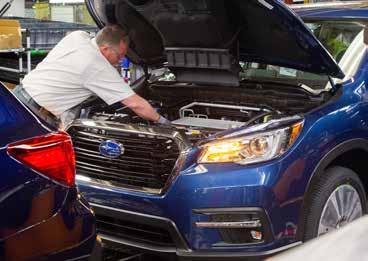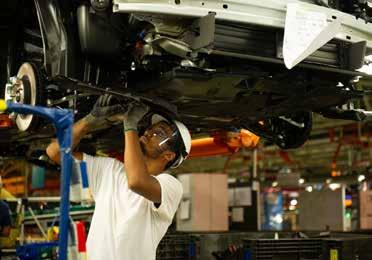
5 minute read
Subaru of Indiana Automotive: A success story that keeps adding chapters
BY ANGELA K. ROBERTS PHOTOS PROVIDED BY SUBARU OF INDIANA AUTOMOTIVE
In 1994, Laurel, Mississippi, native Allen Hodge — who had relocated with his young bride back to her hometown of West Lafayette, Indiana — took a job at a burgeoning automotive factory on the outskirts of Dayton, Indiana. Twenty-five years later, just as Subaru of Indiana Automotive was celebrating the production of its 4 millionth Subaru vehicle, Allen’s son, Jon Hodge, followed in his footsteps by stepping onto the 820-acre campus for the first time as a contract worker.
“It was a combination of planning for my future and accounting for my needs at the time. I wanted a job that paid well and I could make a career out of,” says the 22-year-old Hodge, who works for CTI Personnel as a materials handler, delivering parts to the line for his fellow associates to attach to cars.
The young Hodge says that when his number comes up, SIA will transition him from a temporary job to a permanent one. That may happen sooner than he originally anticipated, given the plant’s recent announcement. In February, SIA released plans to invest $158 million in a new service parts facility and transmission assembly shop, which together will generate 350 new jobs for Greater Lafayette.
Construction will begin this summer on the service parts facility, a stand-alone building, and the transmission assembly shop, an addition to the plant. “We’re proud to continue investing in Indiana,” says Scott Brand, senior vice president of administration and quality.
RAMPING UP PRODUCTION
For years now, local auto dealer and advertising icon Bob Rohrman has urged Greater Lafayette television viewers to “Buy Subaru and keep Lafayette driving.” The tagline has a lot of truth behind it: SIA is woven into the community’s fabric, churning out cars, jobs, customers and community service at a time when some automobile manufacturers are struggling to keep the lights on.
The Lafayette plant is Subaru’s only manufacturing facility outside of Asia and currently employs more than 6,000 associates, of which more than 5,000 work in production. When the plant opened in 1989, associates built the Subaru Legacy and Isuzu Pickup. In the years that followed, SIA continued to produce Subaru models in addition to other vehicles, including the Isuzu Rodeo, Honda Passport and Toyota Camry.
Since June 2016, the plant has exclusively produced Subaru vehicles. Current cars rolling off the assembly line here are the Ascent, Impreza, Legacy and Outback models for North America.
SIA executives project that the plant will build 410,000 cars over the next year. Production levels, in fact, have tripled over the last 10 years, says Brand, and the announced expansion will help the company meet increased customer demand.



LOYAL CUSTOMERS
When it comes to car buying, loyalty is key, according to the data analytics firm J.D. Power and Associates: Loyal drivers will return to buy or lease from the same manufacturer and will recommend the brand to friends and family members.
In the firm’s first-ever loyalty survey in 2019, Subaru ranked highest among mass market brands — and highest overall — with a loyalty rate of 61.5 percent, edging out even the highest-ranked luxury car, Lexus, which topped out at 47.6 percent.
Loyalty and popularity ratings underscore the support of local Subaru drivers like Drew Hallett, a web programmer at Purdue University who shares a Forester with his wife. “It was the best value midsize SUV and seemed to have the most spacious interior,” Hallett says of the car, which they purchased as a pre-owned vehicle.
Hallett, who recommended the Subaru Ascent to his parents when they were car-shopping recently, says he’s had “zero problems” with his SUV: “No single car can do it all, but the Forester comes close.”
For Purdue University graphic designer Sarah Anderson, who had a toddler when she purchased her Forester several years ago, safety was her top priority. “I had done a lot of research and narrowed it down to two options that I really liked,” she says. “We ended up going with the Subaru Forester because of the local reputation and resale value.”
Like many Subaru drivers, Anderson says she loves her car. “I’ve only had a couple small issues, and the team at Subaru have been fabulous to work with,” she says. “It’s a dependable car that gets my family where we want to go safely — with good gas mileage.”
When it came time for her parents to replace their SUV, Anderson convinced them to purchase an Outback. Now, she says, “They even come to Lafayette for service visits.”
SAFETY, ENVIRONMENT & COMMUNITY
For safety-minded buyers like Anderson, features such as adaptive cruise control and pre-collision breaking are innovations that helped the company earn top honors in Kelley Blue Book’s most-trusted brand competition every year from 2015 to 2019. That focus on safety extends to the plant floor as well. In February, SIA was recognized with a Governor’s Workplace Safety Award from the state of Indiana for a 2019 internal awareness campaign that contributed to an 80 percent reduction in slips, trips and falls from the previous year.
Over the past 30 years, the plant also has achieved several environmental milestones. SIA was the first U.S. auto plant

to become smoke-free, earn an ISO 14001 Certification for Environmental Management, be designated as a Backyard Wildlife Habitat by the National Wildlife Federation, achieve zero landfill waste and earn an ISO 50001 Certification for Energy Management, according to Craig Koven, communications and external relations manager.
Those successes are likely rooted in the strong work ethic of SIA’s employees, who undergo a stringent hiring process and rigorous training, and are governed through Kaizen, a system of continuous improvement that emphasizes personal discipline and teamwork.
Associates bring that team spirit into the community with them by volunteering with Wabash Center, the Imagination Station and other local causes. In turn, the SIA Foundation issues grants for capital projects in arts, culture, education, health and welfare in Tippecanoe County and beyond. Given that nonprofits help spur economic activity, that’s another way that SIA keeps Greater Lafayette driving. ★







